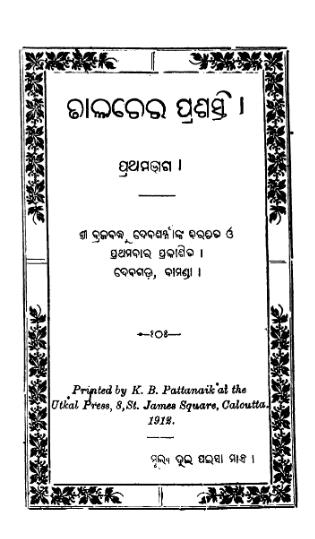In the rich tapestry of Odia literature, the early 20th century was a fertile period for poetic expression, and one shining gem from this era is Talachera Prasasti by Brajabandhu Debasharma, published in 1912. This collection not only showcases Debasharma’s poetic prowess but also serves as an important cultural artifact that reflects the spiritual and social milieu of Odisha during that time. The title itself, translating to The Praise of Talachera, hints at the deep sense of reverence and devotion that permeates the work.
Talachera Prasasti is a poem that stands as a vibrant tribute to the spirit of the Odia people, particularly focusing on themes of worship, nature, and the divine connection that is central to Odia culture. Debasharma draws upon a rich tradition of devotional poetry, melding it with poignant reflections on the beauty of the natural world. This intersection of the sacred and the secular invites readers to explore the intricate relationship between humanity and divinity, as well as the ways in which nature nurtures the soul.
One of the most striking features of Talachera Prasasti is Debasharma’s exquisite use of language. His choice of words and phrases is deeply evocative, immersing readers in the vibrant imagery of Odisha’s landscapes. The poet paints pictures of lush fields, flowing rivers, and serene temples, allowing readers to feel the essence of the land itself. This lyrical quality enhances the emotional resonance of the poems, inviting readers to experience both the beauty of nature and the depth of spiritual yearning.
Furthermore, the rhythm and meter of Debasharma’s poetry contribute to its musicality, making it a delight to read aloud. His verses flow effortlessly, echoing the oral traditions that are an integral part of Odia culture. This aspect not only honors the rich heritage of Odia literature but also ensures that the essence of the poems can be passed down through generations, preserving the beauty of language and tradition.
A devotional undertone runs through Talachera Prasasti, showcasing Debasharma’s deep reverence for the divine. He skillfully incorporates elements of Bhakti (devotion) philosophy, which emphasizes a personal connection with God. This connection is often expressed through metaphors of love and longing, reflecting the emotional intensity inherent in spiritual practices. Debasharma’s work becomes a vessel for expressing devotion, encouraging readers to contemplate their own relationships with the divine.
Moreover, Talachera Prasasti serves as a mirror to the cultural identity of Odisha. It encapsulates the ethos of the Odia people, celebrating traditional values while also highlighting the region’s unique customs and rituals. Through his poetry, Debasharma fosters a sense of pride in local heritage, urging readers to embrace their roots and acknowledge the beauty that their culture encompasses.
In a wider context, the publication of Talachera Prasasti during a time of social change and awakening in India is noteworthy. The 1910s were marked by movements advocating for cultural revival and self-identity. By contributing to this literary tradition, Debasharma not only enriches Odia literature but also aligns himself with a broader narrative of cultural resurgence.
Books Info
| Books name | Talachera Prasasti / ତାଳଚେର ପ୍ରଶସ୍ତି |
| Author | Brajabandhu Debasharma |
| No Of pages | 23 |
| Publisher | NA |
| Publication | 1912 |
| Printed At | The Utkal Press |
| Distributor | NA |

